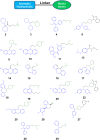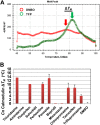A repurposing approach identifies off-patent drugs with fungicidal cryptococcal activity, a common structural chemotype, and pharmacological properties relevant to the treatment of cryptococcosis
- PMID: 23243064
- PMCID: PMC3571299
- DOI: 10.1128/EC.00314-12
A repurposing approach identifies off-patent drugs with fungicidal cryptococcal activity, a common structural chemotype, and pharmacological properties relevant to the treatment of cryptococcosis
Abstract
New, more accessible therapies for cryptococcosis represent an unmet clinical need of global importance. We took a repurposing approach to identify previously developed drugs with fungicidal activity toward Cryptococcus neoformans, using a high-throughput screening assay designed to detect drugs that directly kill fungi. From a set of 1,120 off-patent medications and bioactive molecules, we identified 31 drugs/molecules with fungicidal activity, including 15 drugs for which direct antifungal activity had not previously been reported. A significant portion of the drugs are orally bioavailable and cross the blood-brain barrier, features key to the development of a widely applicable anticryptococcal agent. Structural analysis of this set revealed a common chemotype consisting of a hydrophobic moiety linked to a basic amine, features that are common to drugs that cross the blood-brain barrier and access the phagolysosome, two important niches of C. neoformans. Consistent with their fungicidal activity, the set contains eight drugs that are either additive or synergistic in combination with fluconazole. Importantly, we identified two drugs, amiodarone and thioridazine, with activity against intraphagocytic C. neoformans. Finally, the set of drugs is also enriched for molecules that inhibit calmodulin, and we have confirmed that seven drugs directly bind C. neoformans calmodulin, providing a molecular target that may contribute to the mechanism of antifungal activity. Taken together, these studies provide a foundation for the optimization of the antifungal properties of a set of pharmacologically attractive scaffolds for the development of novel anticryptococcal therapies.
Figures





Similar articles
-
Estrogen receptor antagonists are anti-cryptococcal agents that directly bind EF hand proteins and synergize with fluconazole in vivo.mBio. 2014 Feb 11;5(1):e00765-13. doi: 10.1128/mBio.00765-13. mBio. 2014. PMID: 24520056 Free PMC article.
-
Synergistic and antagonistic drug interactions in the treatment of systemic fungal infections.Elife. 2020 May 5;9:e54160. doi: 10.7554/eLife.54160. Elife. 2020. PMID: 32367801 Free PMC article.
-
Astemizole and an analogue promote fungicidal activity of fluconazole against Cryptococcus neoformans var. grubii and Cryptococcus gattii.Med Mycol. 2010 Mar;48(2):255-62. doi: 10.1080/13693780903081968. Med Mycol. 2010. PMID: 19572230
-
Searching for new antifungals for the treatment of cryptococcosis.Rev Soc Bras Med Trop. 2023 Jul 24;56:e01212023. doi: 10.1590/0037-8682-0121-2023. eCollection 2023. Rev Soc Bras Med Trop. 2023. PMID: 37493736 Free PMC article. Review.
-
Off-label treatments as potential accelerators in the search for the ideal antifungal treatment of cryptococcosis.Future Microbiol. 2023 Jan;18:127-135. doi: 10.2217/fmb-2022-0122. Epub 2023 Jan 23. Future Microbiol. 2023. PMID: 36688321 Review.
Cited by
-
Accumulation of endogenous free radicals is required to induce titan-like cell formation in Cryptococcus neoformans.mBio. 2024 Jan 16;15(1):e0254923. doi: 10.1128/mbio.02549-23. Epub 2023 Dec 11. mBio. 2024. PMID: 38078728 Free PMC article.
-
Proteasome inhibition as a therapeutic target for the fungal pathogen Cryptococcus neoformans.Microbiol Spectr. 2023 Sep 26;11(5):e0190423. doi: 10.1128/spectrum.01904-23. Online ahead of print. Microbiol Spectr. 2023. PMID: 37750732 Free PMC article.
-
Repurposing Benzimidazoles against Causative Agents of Chromoblastomycosis: Albendazole Has Superior In Vitro Activity Than Mebendazole and Thiabendazole.J Fungi (Basel). 2023 Jul 16;9(7):753. doi: 10.3390/jof9070753. J Fungi (Basel). 2023. PMID: 37504741 Free PMC article.
-
Development of an Imaging Flow Cytometry Method for Fungal Cytological Profiling and Its Potential Application in Antifungal Drug Development.J Fungi (Basel). 2023 Jun 30;9(7):722. doi: 10.3390/jof9070722. J Fungi (Basel). 2023. PMID: 37504711 Free PMC article.
-
Recent drug development and treatments for fungal infections.Braz J Microbiol. 2023 Sep;54(3):1695-1716. doi: 10.1007/s42770-023-00999-z. Epub 2023 May 23. Braz J Microbiol. 2023. PMID: 37219748 Free PMC article. Review.
References
-
- Park BJ, Wannemuehler KA, Marston BJ, Govender N, Pappas PG, Chiller TM. 2009. Estimation of the current global burden of cryptococcal meningitis among persons living with HIV/AIDS. AIDS 23:525–530 - PubMed
-
- Kwon-Chung KJ, Boekhout T, Wickes BL, Fell J. 2011. Systematics of the genus Cryptococcus and its type species C. neoformans, p 3–17 In Heitman J, Kozel TR, Kwon-Chung KJ, Perfect JR, Casadevall A. (ed), Cryptococcus: from human pathogen to model yeast. ASM Press, Washington, DC
-
- Perfect JR. 2012. The triple threat of cryptococcosis: it's the body site, the strain and/or the host. mBio 3:e100165–12 doi:10.1128/mBio.00165-12 - DOI - PMC - PubMed
-
- Perfect JR, Dismukes WE, Dromer F, Goldman DL, Graybill JR, Hamill RJ, Harrison TS, Larsen RA, Lortholary O, Nguyen MH, Pappas PG, Powderly WG, Singh N, Sobel JD, Sorrell TC. 2010. Clinical practice guidelines for the management of cryptococcal disease: 2010 update by the Infectious Diseases Society of America. Clin. Infect. Dis. 50:291–322 - PMC - PubMed
Publication types
MeSH terms
Substances
Grants and funding
LinkOut - more resources
Full Text Sources
Other Literature Sources

